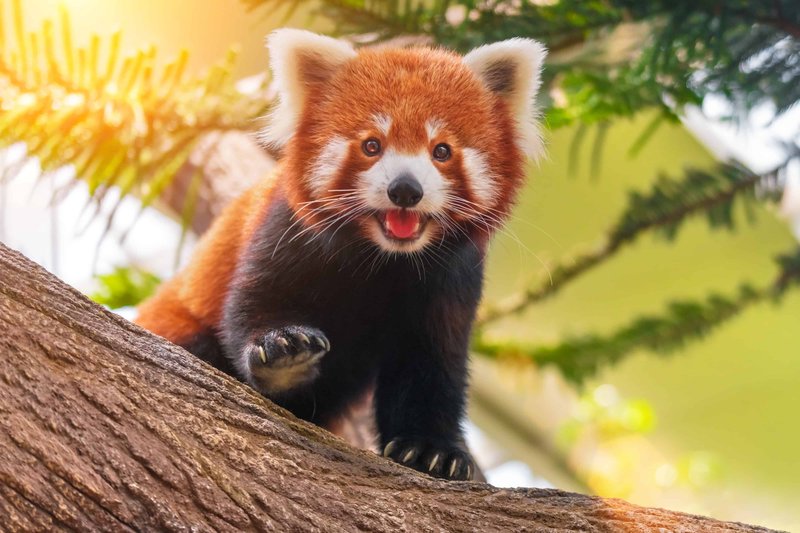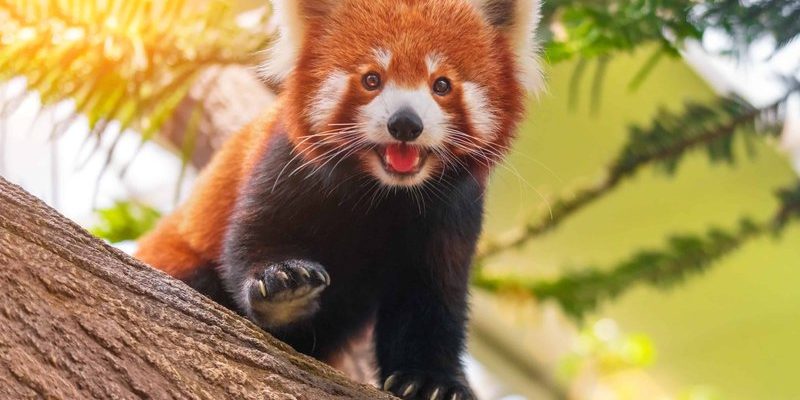
The process of raising young red pandas is a remarkable journey filled with challenges and joys. So, let’s dive into the world of these enchanting animals, exploring how they care for their young in the wild, and what makes their parenting unique.
The Mating Season: When It All Begins
Red pandas have a specific mating season that occurs in late winter or early spring. This timing isn’t just random; it ensures that the cubs are born in spring, when food is plentiful. Imagine trying to feed a baby at a time when there’s not much to eat—nature knows better!
During this season, male red pandas will compete for the attention of females. They use vocalizations, scent markings, and even playful sparring. The male’s role during this time is important, but it’s not about providing for the young — it’s all about winning over a mate. After a brief courtship, the female chooses her partner, leading to a very different phase of life just a few months later.
The female red panda has a gestation period of about 90 to 150 days. Typically, she gives birth to one to four cubs, but two is the most common number. Each cub weighs roughly as much as a small banana and is completely dependent on its mother. Here’s the thing: red panda mothers are incredibly nurturing, and they invest a lot of energy into caring for their newborns.
Choosing a Den: A Safe Home for Cubs
Once a female red panda is pregnant, she seeks out the perfect den to raise her young. Dens are often located in tree hollows or thick foliage, providing shelter from predators and harsh weather. It’s kind of like picking the right neighborhood; safety is key.
The mother will prepare her den with soft materials like leaves and grasses, creating a cozy space for her cubs. This setting is vital, as the cubs are born blind and hairless, making them vulnerable. Think about how helpless a newborn is—it’s the same for red panda cubs. The den becomes their world, where they will spend the first few weeks of life.
As the cubs grow, the mother rarely leaves the den. She stays close, nursing and keeping them warm. You might be wondering how she manages to eat enough during this time. Well, red pandas are excellent foragers and will often leave the den briefly to find bamboo, her primary source of nourishment, and other fruits.
The First Weeks: Nurturing and Nursing
After birth, red panda cubs spend their first few weeks entirely dependent on their mother for food and warmth. This stage is critical for their survival. The mother nurses them frequently, which helps them grow quickly. It’s an intense job, as she has to ensure they’re safe and healthy while also keeping her energy up to care for them.
In the wild, you’ll often find the cubs cuddled together, huddling for warmth. They remain in the den for about 12 weeks, during which time they start to open their eyes and develop some mobility. By about two months, they begin to explore their surroundings under their mother’s watchful eye, learning crucial skills for survival.
This part of their early life is a mix of play and learning. As they grow, you might see them practicing climbing, which is essential for their future in the trees. All this playful exploration is actually a way for them to develop their muscles and coordination, preparing them for their independent lives.
Mother’s Role: Protector and Teacher
Once the cubs are old enough to leave the den, the mother’s role shifts slightly. She becomes more of a teacher and protector. This stage is fascinating because she encourages them to explore their environment while still keeping them safe from potential dangers.
The mother will take her cubs on little outings, showing them where to find food and how to climb trees. Each outing is a lesson. Honestly, it’s a bit like teaching a toddler how to navigate a playground—lots of supervision, patience, and a few “don’t climb too high” warnings.
During this time, the cubs learn essential life skills. They practice their climbing and foraging skills, which are vital for their survival. The mother will demonstrate how to find bamboo and other food sources, gradually letting the cubs take the lead. It’s a balance of guidance and independence, allowing them to build confidence.
Independence: When Do Cubs Leave Their Mother?
As the cubs reach about six months old, they start becoming more independent. You might notice them roaming farther from their mother, testing their skills on their own. This is a natural part of their development, signaling that they’re learning to survive on their own.
By the time they are about a year old, they’re typically ready to leave their mother’s side for good. It’s a bittersweet moment for the mother, who has invested so much effort into raising them. But it’s also a triumph, knowing that she has equipped them with the skills they need to thrive in the wild.
Interestingly, red pandas are solitary animals, so once the cubs leave, they won’t often see their mother again. This independence helps reduce competition for resources and allows the young pandas to carve out their own territories.
Challenges in the Wild: The Struggles of Parenthood
Parenting isn’t easy for red pandas, and there are challenges they face. The loss of habitat due to deforestation and human encroachment makes finding safe dens more difficult. Without adequate shelter, cubs may be more vulnerable to predators. It’s like trying to raise kids in a constantly changing neighborhood—safety is a top concern.
Another challenge is food scarcity. As bamboo forests are threatened, the availability of food for both mothers and cubs can diminish. This scarcity can lead to increased competition, affecting the health and growth of the young. A mother has to not only care for her cubs but also work harder to find enough food.
Moreover, climate change is impacting red panda habitats, leading to shifts in their environment. As temperatures rise, their preferred bamboo species may become less abundant, complicating their food supply. Every year, these hurdles make it harder for red pandas to raise successful offspring.
Conservation Efforts: Supporting Red Panda Families
Conserving red pandas and their habitats is crucial for their survival. Many organizations work tirelessly to create awareness and provide support for habitat preservation. These conservation efforts are like a safety net, ensuring these cute animals have the resources they need to thrive.
One approach is establishing protected areas where red pandas can live without the threat of habitat loss. By preserving forests and encouraging sustainable practices, we can help support both the animals and the ecosystem.
Additionally, educating communities about the importance of red pandas can foster a sense of responsibility and encourage conservation. It’s like creating a team effort—everyone can play a role in ensuring that these beautiful creatures continue to thrive in the wild.
Ultimately, protecting red pandas means giving them a chance to raise their young successfully, ensuring their species can flourish for future generations.
In conclusion, red pandas are incredible parents who face unique challenges when raising their young. From the careful selection of a den to teaching their cubs vital life skills, these mothers put in hard work and dedication. By supporting red panda conservation efforts, we can ensure that this charming species continues to thrive in their natural habitats for years to come.

